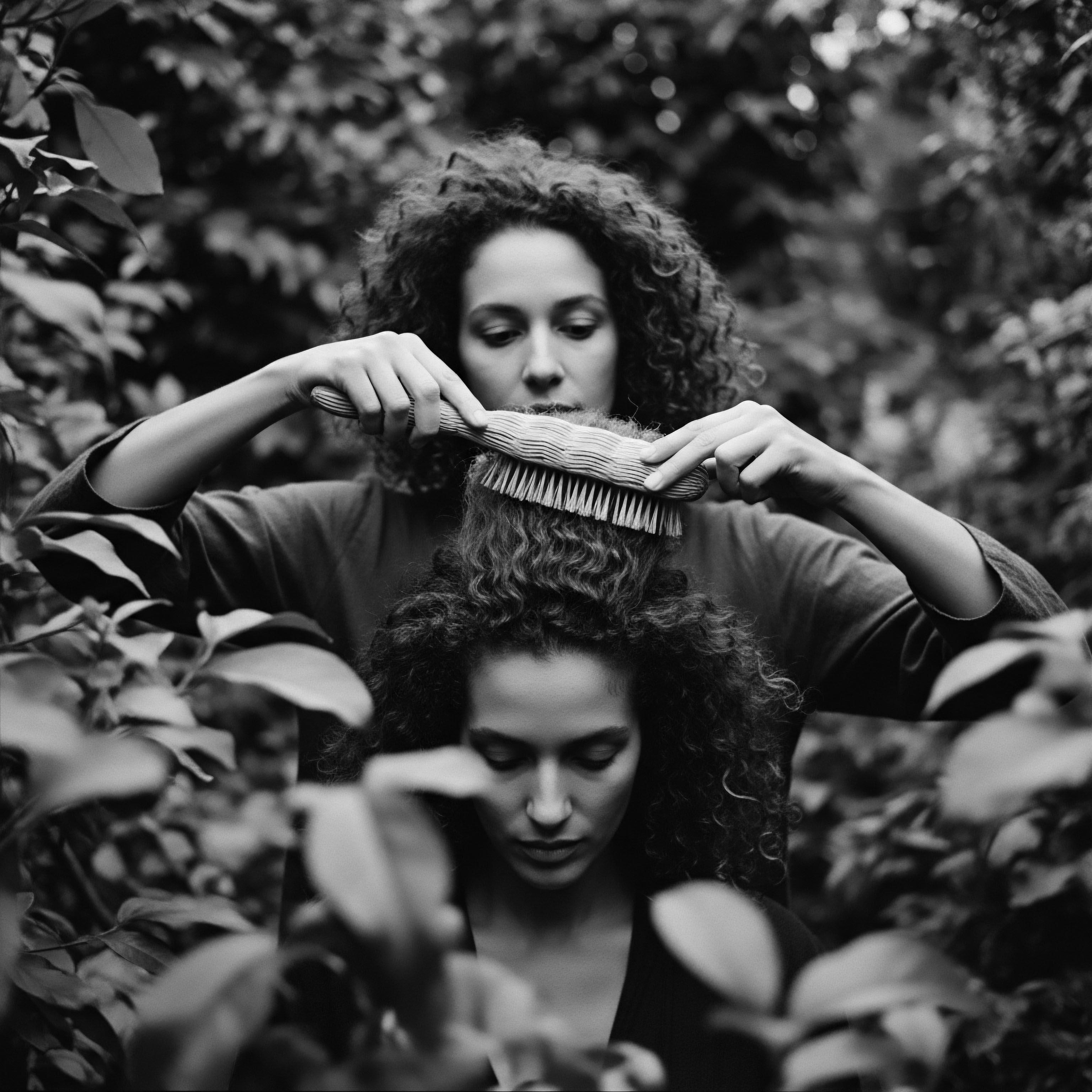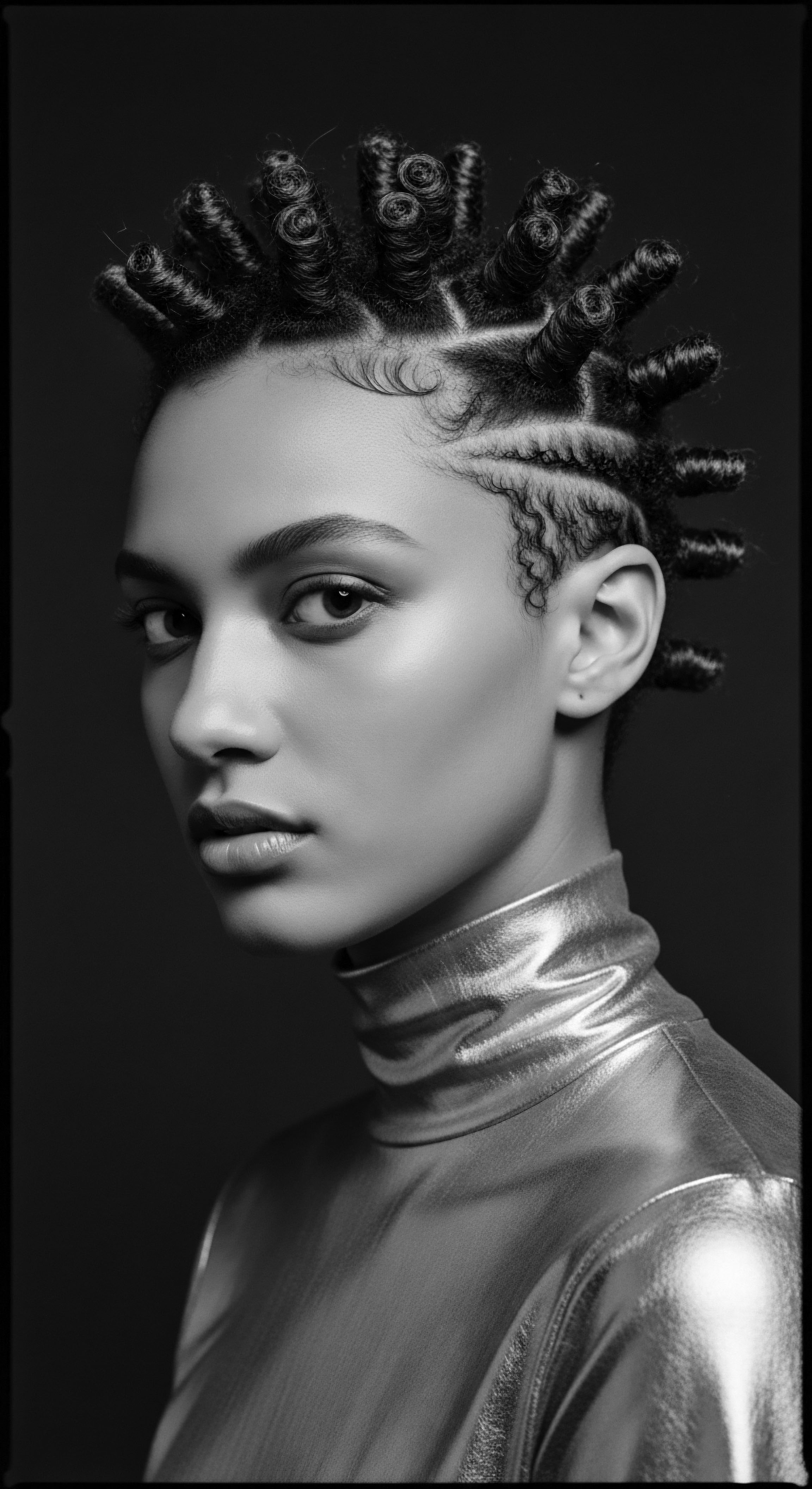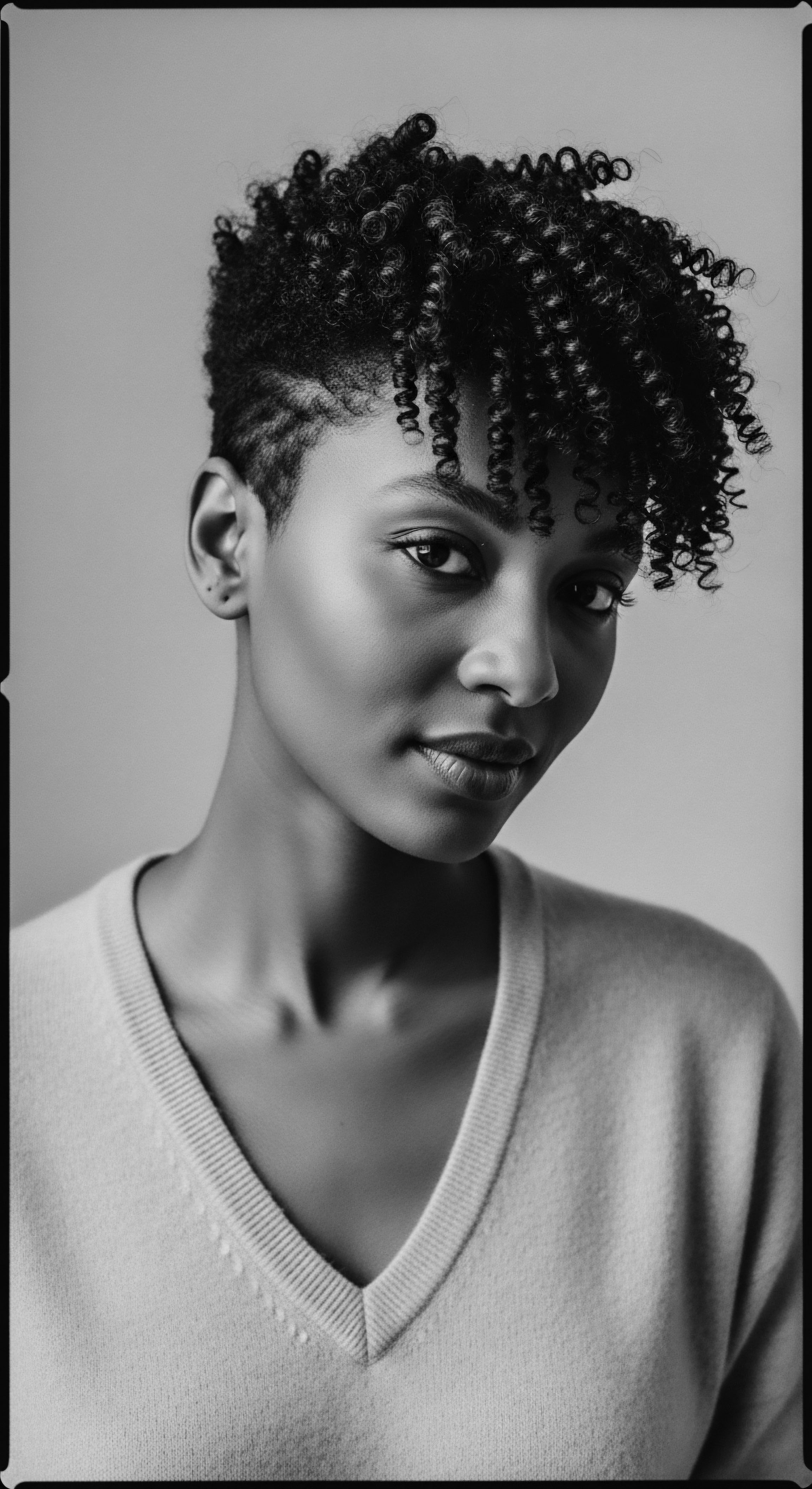
Roots
To stand before a textured strand of hair is to stand at the crossroads of antiquity and innovation, a vibrant nexus where the very fabric of identity and ancestral memory resides. For too long, the nuanced coil, the resilient wave, and the majestic kink have been misunderstood, often viewed through a lens that missed their inherent strength and profound cultural narrative. We speak now not merely of hair, but of a living archive, a repository of stories etched in every curve and twist, carrying the echoes of millennia.
Can the ancient art of oiling, practiced in the sun-drenched lands of our forebears, truly offer modern textured hair a pathway to enduring health? This inquiry guides us, seeking wisdom from epochs past to illuminate our path forward.

The Architectures of Textured Hair
The biological framework of textured hair, often marvelled at in its diversity, holds a unique story. Each strand, born from a follicle shaped not unlike a delicate ribbon, spirals forth, granting the hair its characteristic curl pattern. This helical growth creates a natural propensity for dryness, as the oils produced by the scalp, called sebum, struggle to travel down the winding shaft. Ancestral practices instinctively countered this, understanding that lubrication was not simply about shine, but about maintaining the structural integrity of the strand.
Consider the varying diameters and elliptical cross-sections that distinguish coily and kinky textures. These architectural variances mean textured hair tends to possess more cuticle layers than straighter hair, yet these layers are often raised or less tightly bound. This makes textured hair more susceptible to environmental factors and mechanical stress. The wisdom of our ancestors, passed down through generations, often centered on fortifying this protective outer layer, a testament to an intuitive understanding of hair’s elemental needs.

Words of the Strand A Lexicon of Legacy
Our language around textured hair has evolved, yet many contemporary terms sometimes fall short of capturing its complete essence and historical significance. Old forms of speaking, rooted in specific cultural contexts, offered a richer vocabulary for describing hair and its care. To truly appreciate the practice of hair oiling, one might revisit terms that speak to its deep place within various communities.
- Sneha ❉ From Sanskrit, meaning both “oil” and “to love,” this word encapsulates the Ayurvedic practice of oiling as a gesture of profound affection and care, not just for the hair but for the entire being.
- Champi ❉ A traditional Indian head massage, often incorporating warm oils, that is the origin of the English word “shampoo.” It highlights the therapeutic and bonding aspects of ancient oiling rituals.
- Karite ❉ The indigenous name for the shea tree, from which shea butter is derived. This term roots the celebrated ingredient in its West African origins, where it has been a sacred commodity for centuries.

Cycles of Growth and Ancestral Influences
The life cycle of a hair strand—its growth, resting, and shedding phases—is a universal biological rhythm. Yet, ancestral environments, diets, and daily routines profoundly shaped the health and resilience of hair. In climates where sun exposure was constant or arid winds prevailed, natural oils and butters became vital shields.
The inclusion of nutrient-dense botanicals in traditional oils also provided nourishment, acting as precursors to modern vitamin and mineral supplements. These practices were not random acts but carefully observed adaptations to the world around them.
Ancient oiling practices offered an intuitive defense against environmental stressors, fortifying textured hair for generations.
The wisdom embedded in these ancestral care routines was often holistic, recognizing that external application worked in tandem with internal well-being. Diet, communal well-being, and even spiritual practices were seen as contributors to overall vitality, reflecting on the health of the hair. This integrated perspective, now often rediscovered through modern wellness movements, was the very bedrock of heritage hair care.

Ritual
The act of oiling hair, stretching back through time, transcends a simple beauty treatment; it manifests as a profound ritual, a dance between human touch and nature’s bounty. This practice, particularly for textured hair, shaped styling traditions, fortified protective forms, and even influenced the very tools crafted for tending the crown. It connects us to a heritage of resilience, creativity, and self-care that continues to echo in contemporary practices.

Oiling and Protective Styles
Across African and diasporic communities, protective styles such as braids, twists, and cornrows held immense cultural and practical significance. These styles were not merely adornments; they preserved hair from environmental damage, minimized breakage, and sometimes even conveyed social status or tribal identity. The application of oils and butters was a foundational step in these processes.
Before braiding, oils often prepared the hair, making it pliable, reducing friction, and adding a layer of moisture that locked within the style, extending its life and protecting the hair underneath. This practice speaks to an inherited wisdom about maintaining hair health over extended periods.
For example, the widespread use of Shea Butter in West Africa for centuries underscores this symbiotic relationship between oiling and protective styling. Women would hand-process shea nuts to extract this rich butter, then apply it to their hair before and during braiding, providing moisture and a protective barrier against the sun and dust. This tradition continues today, a living testament to its efficacy.

Defining Techniques and Ancestral Methods
Beyond protective styles, traditional oiling was integral to defining natural texture and promoting overall hair vitality. The deliberate anointing of strands, often with warmed oils, softened the hair, enhanced its natural curl pattern, and imparted a healthy lustre. This wasn’t merely about visual appeal; it was about the tactile experience, the sensory connection to one’s heritage, and the strengthening of hair fibers. Ancient texts, like the Rig Veda (around 3500 years old), speak of the Goddess Usha having hair “anointed with the oil of the lotus,” highlighting the early and sacred nature of these treatments.
| Traditional Practice Warm Oil Massage |
| Ancestral Context Ayurvedic tradition to stimulate circulation and promote relaxation, believed to unblock the Crown Chakra. |
| Modern Corroboration for Textured Hair Increases blood flow to scalp, delivering nutrients to follicles, potentially reducing scalp irritation and supporting a healthy growth environment. |
| Traditional Practice Pre-wash Oiling |
| Ancestral Context Common in Indian and African cultures to prevent protein loss and add protection before cleansing. |
| Modern Corroboration for Textured Hair Scientific studies show coconut oil, when applied before washing, can significantly reduce protein loss in hair by 41.8%. |
| Traditional Practice Application with Protective Styles |
| Ancestral Context Used with braids, twists, and cornrows in African traditions to moisturize and protect hair from elements. |
| Modern Corroboration for Textured Hair Helps seal in moisture, reduces friction, and minimizes breakage during manipulation and styling, especially for coil and kink patterns. |
| Traditional Practice These timeless methods speak to a deep understanding of textured hair's needs, validated by contemporary observations. |

Tools from the Past and Present
The implements used to tend hair, alongside the oils, tell their own stories. In ancient Egypt, combs were fashioned from wood or ivory, promoting gentle detangling. Across Africa, various natural tools were used, reflecting the local resources and specific hair textures. These were designed to work with, rather than against, the hair’s natural inclinations, minimizing stress and breakage—a crucial consideration for textured hair.
Today’s tools may be made of different materials, but the principles remain similar ❉ gentleness, efficacy, and respect for the hair’s structure. The careful application of oil by hand, a practice common to many ancient rituals, naturally warms the oil and ensures thorough, tactile distribution, something modern applicators might struggle to replicate. This personal touch, a hallmark of ancestral care, carries a legacy of connection and intimacy with one’s hair.
The intentional warming and massaging of ancient oils formed a tactile bond between caregiver and hair, a legacy of intuitive care.
The historical use of specific plants in different regions also highlights the localized intelligence of hair care. Native American tribes, for instance, utilized bear grease or fish oil for conditioning and protection, while Aboriginal communities in Australia applied emu oil and tea tree oil for their conditioning and antimicrobial properties. These choices underscore a profound relationship with the land and its offerings, further cementing the heritage aspect of these oiling rituals.

Relay
The wisdom of ancestral hair oiling, carried through generations, offers more than a historical curiosity; it presents a practical, profound framework for modern textured hair health. This enduring tradition, steeped in the knowledge of diverse communities, particularly those of African and mixed-race descent, informs holistic care, addresses persistent challenges, and underscores the deep connection between hair and overall well-being. We stand on the shoulders of those who came before, receiving their legacy as a living testament to effective hair tending.

Crafting Care Routines from Ancient Blueprints
Building a contemporary hair regimen that truly honors textured hair often begins by revisiting ancestral blueprints. The rhythmic application of oils, the patient massaging of the scalp, and the mindful approach to cleansing were not isolated acts. They formed a cohesive system, a preventative and restorative cycle.
This historical consistency offers a powerful counterpoint to the often fragmented, product-driven routines of today. The systematic use of specific oils for specific concerns, as seen in Ayurvedic practices, is a remarkable example of this deliberate approach.
For instance, traditional Indian hair oiling, practiced for over 4,000 years, emphasizes the pre-wash application of oils. A study published in 2003 demonstrated that Coconut Oil, when applied as a pre-wash treatment, significantly reduces protein loss in hair. This finding validates a practice passed down through countless generations, showcasing how ancient wisdom can meet modern scientific understanding.
The effectiveness of this pre-wash oiling ritual for protein loss is particularly pertinent for textured hair, which is inherently more vulnerable to hygral fatigue – the repeated swelling and shrinking of the hair shaft when exposed to water, leading to weakness and breakage. Coconut oil, with its low molecular weight and affinity for hair proteins, penetrates the hair shaft, reducing water absorption and strengthening the hair from within.

The Nighttime Sanctuary ❉ Preserving Strands
The practice of protecting hair at night is not a recent innovation but a deeply rooted ancestral custom. From the elaborate wraps of ancient Egyptian nobility to the practical head coverings worn by many African women, safeguarding hair during sleep prevented tangles, retained moisture, and maintained hairstyles. Oiling was often an integral part of this ritual, applied before hair was wrapped or braided for the night. This nightly discipline meant hair received prolonged nourishment, allowing oils to truly penetrate and condition the strands.
The Silk Bonnet or scarf, a staple for many with textured hair today, directly descends from these protective traditions. It serves as a soft, friction-reducing cocoon, preserving delicate coils and kinks that are prone to mechanical damage against rough fabrics. The synergy of a nourishing oil applied before donning a silk covering is a direct continuation of ancestral practices, providing continuous conditioning and minimizing daily manipulation that could lead to breakage.

Traditional Ingredients and Their Contemporary Science
The pharmacopeia of ancestral hair care is rich with botanical ingredients, many of which are now validated by modern scientific inquiry. Understanding these ingredients, their origins, and their traditional uses offers a potent guide for selecting truly beneficial products today.
- Coconut Oil ❉ Historically used in Indian and African cultures, its scientific benefit lies in its unique molecular structure, allowing it to penetrate the hair shaft and reduce protein loss, especially relevant for highly porous textured hair.
- Shea Butter ❉ A centuries-old staple from West Africa, prized for its emollient properties. Modern understanding highlights its richness in vitamins A and E, providing moisturization and protection against environmental stressors.
- Jojoba Oil ❉ While traditionally used by Indigenous communities in North America, modern science recognizes it as a wax ester that mimics the scalp’s natural sebum, offering lightweight hydration and balancing oil production without clogging pores.
- Argan Oil ❉ Sourced from Moroccan argan trees, this “liquid gold” has been used for centuries. Its benefits for hair include conditioning, improving shine, and protecting against oxidative damage due to its fatty acids, antioxidants, and vitamin E content.
These ingredients are not merely “natural”; they are time-tested, geographically specific, and carry the collective wisdom of generations who relied on their immediate environment for wellness.

Addressing Hair Challenges with Ancestral Wisdom
Many common textured hair challenges—dryness, breakage, frizz, and scalp irritation—were addressed by ancestral methods with remarkable efficacy. The focus on regular oiling, gentle handling, and protective styles directly mitigates these issues. For example, massaging oils into the scalp, a cornerstone of Ayurvedic and African hair care, promotes circulation and can help address conditions like dandruff and dryness by providing direct nourishment to the follicular environment.
How do ancestral methods adapt to modern concerns like hair breakage?
Ancestral practices, particularly consistent oil application and protective styling, significantly reduce the mechanical stress that causes breakage in textured hair. The daily manipulation, styling, and environmental exposure that lead to wear and tear are precisely what oiling combats. By coating the hair shaft, reducing friction during detangling, and maintaining moisture, oils fortify the hair’s defenses, allowing it to reach its full length and vibrancy, much as it did for our foremothers. The continuity of these practices, passed through family lines, stands as evidence of their sustained efficacy.
The persistent application of hair oils, a practice steeped in historical wisdom, demonstrably fortifies hair against the constant wear of daily life.
The wisdom embedded in ancient oiling rituals offers a profound answer to the question of improving modern textured hair health. It is a heritage of intimate knowledge, environmental harmony, and deep self-care that continues to provide vital lessons for us all. The scientific validation of many traditional practices only further cements their enduring relevance, bridging the temporal gap between ancient wisdom and contemporary understanding.

Reflection
The journey through ancient hair oiling rituals, viewed through the lens of textured hair heritage, reveals more than simply a collection of practices. It reveals a living, breathing archive of resilience, ingenuity, and profound connection. Each carefully warmed oil, each deliberate massage, each protective style whispers stories of survival, identity, and quiet strength. The “Soul of a Strand” truly finds its voice in this deep continuum, acknowledging that our hair carries not just genetic markers but also the indelible imprints of generations who understood its sacred nature.
The question of whether these ancestral ways can truly improve modern textured hair health is answered not merely with a “yes,” but with a resonant affirmation that stretches beyond the purely physical. It is a return to an intuitive relationship with our bodies and the earth, a reclamation of practices that nourished both hair and spirit. The scientific confirmations of oil benefits, like coconut oil’s protein protection, merely serve to explain what our ancestors knew through generations of lived experience and observation. This legacy urges us to look beyond fleeting trends and embrace the enduring wisdom that has sustained textured hair across diverse climates and historical adversities.
In every application of oil, in every moment of mindful care, we honor a heritage that reminds us hair is not just an adornment. It is a conduit to our past, a canvas for our present, and a promise for our future. The echoes from the source resonate powerfully, offering not just healthier strands, but a richer, more grounded sense of self.

References
- Ayurvedic Hair Oiling – Roots & Rituals. (2022). Health Canal.
- STYLECIRCLE. (n.d.). Origins of Beauty ❉ Hair Oiling.
- Brown History. (2023). The Bonding Ritual of Hair Oiling.
- Obscure Histories. (2024). Champi ❉ The ancient Indian practice.
- Scarring Alopecia Foundation. (2024). Hair Oils ❉ Do Coconut, Castor, and Argan Oils Really Work?
- Discovering the Origins of Shea Butter – A Journey to the Heart of Africa. (2024). Noire ô Naturel.
- Traditional Indigenous Haircare ❉ Ancient Wisdom for Modern Hair Concerns. (2023). Curly Culture.
- BeBeautiful. (2025). Jojoba Oil for Hair Growth ❉ What Science Says.
- sheabutter.net. (n.d.). A History of Shea Butter.
- Sister Sky. (2023). Natural Oils Native Americans used for Long, Healthy, and Soft Hair.
- Paulski Art. (2024). The Rich History of Shea Butter and Its Origins.
- Kama Ayurveda. (2023). The Ancient Indian Tradition of Hair-Oiling and Why You Should Start Doing It Now.
- 22 Ayur. (n.d.). The Ancient Natural Ways of Hair Care Across Continents.
- Substack. (2025). Ancestral Hair Rituals to Nourish Your Hair and Soul.
- Nature’s Little Secret. (2025). The History of Black Hair Care ❉ Trailblazers Who Paved the Way.
- Health. (2024). Coconut Oil For Hair ❉ Benefits and How To Use.
- Sew Historically. (2015). Night-Time Hair Routine – Victorian And Edwardian Hair Care.
- Ciafe. (2023). Shea Butter – Explainer.
- Pravek Kalp. (2024). Traditional Ayurvedic Hair Oil ❉ Benefits & Key Ingredients.
- Karethic. (2016). The history of Shea.
- Joanna Colomas. (2023). Unlock Ancient Hair Care Secrets ❉ Discover Global Rituals for Lustrous Locks.
- HINU. (n.d.). The Aboriginal Wisdom in Hair Care.
- Healthline. (2021). Benefits of Using Coconut Oil in Your Hair.
- Cécred. (2025). Understanding Hair Oiling ❉ History, Benefits & More.
- BLAM UK CIC. (2022). The history of Black Hair.
- Healthline. (2017). Jojoba Oil For Hair ❉ Loss, Benefits, and How to Use.
- Noireônaturel. (n.d.). The Benefits of Natural Products to Enhance Your Textured Hair.
- PsychoHairapy. (2024). Our Hair ROOTS ❉ Incorporating our Black Family Hair Traditions and Routines as a Coping Technique to Increase Positive Mental Health.
- Historical Perspectives on Hair Care and Common Styling Practices in Black Women. (2025). Current Problems in Dermatology.
- Clinikally. (2024). Reviving Ancient Hair Rituals ❉ Exploring the Therapeutic Art of Hair-Oiling.
